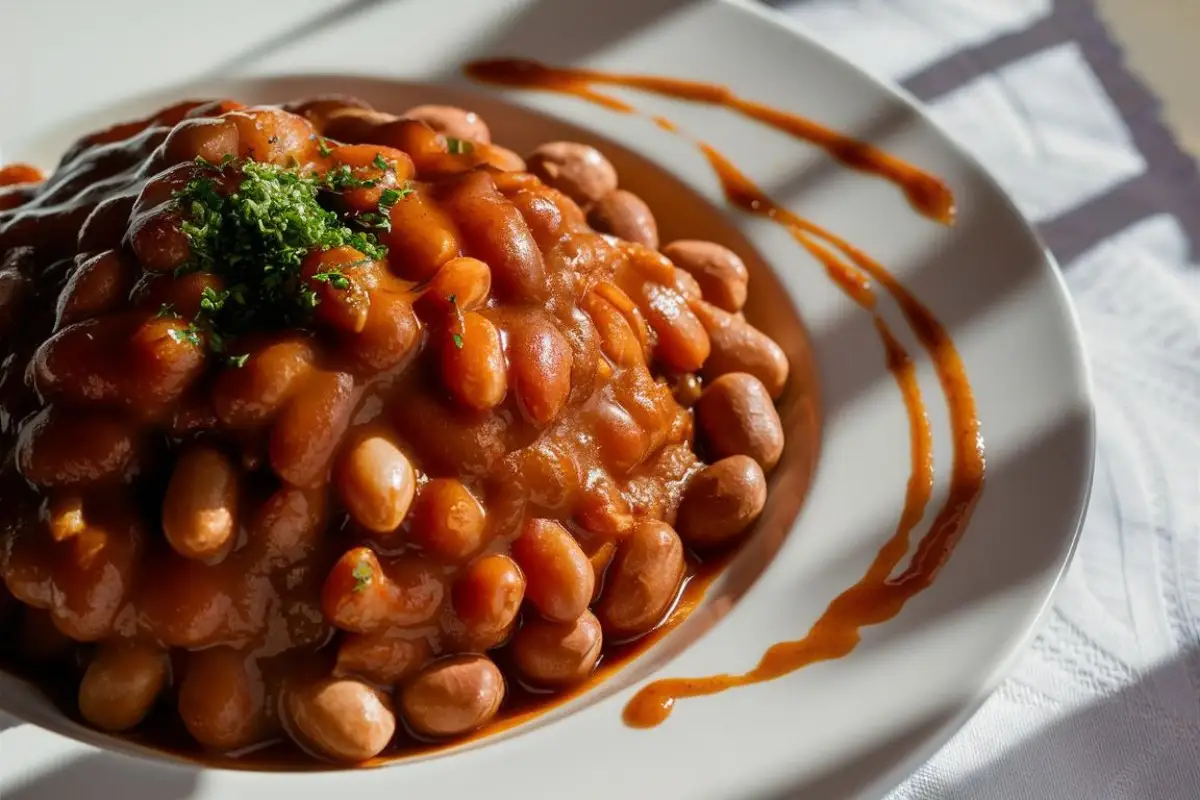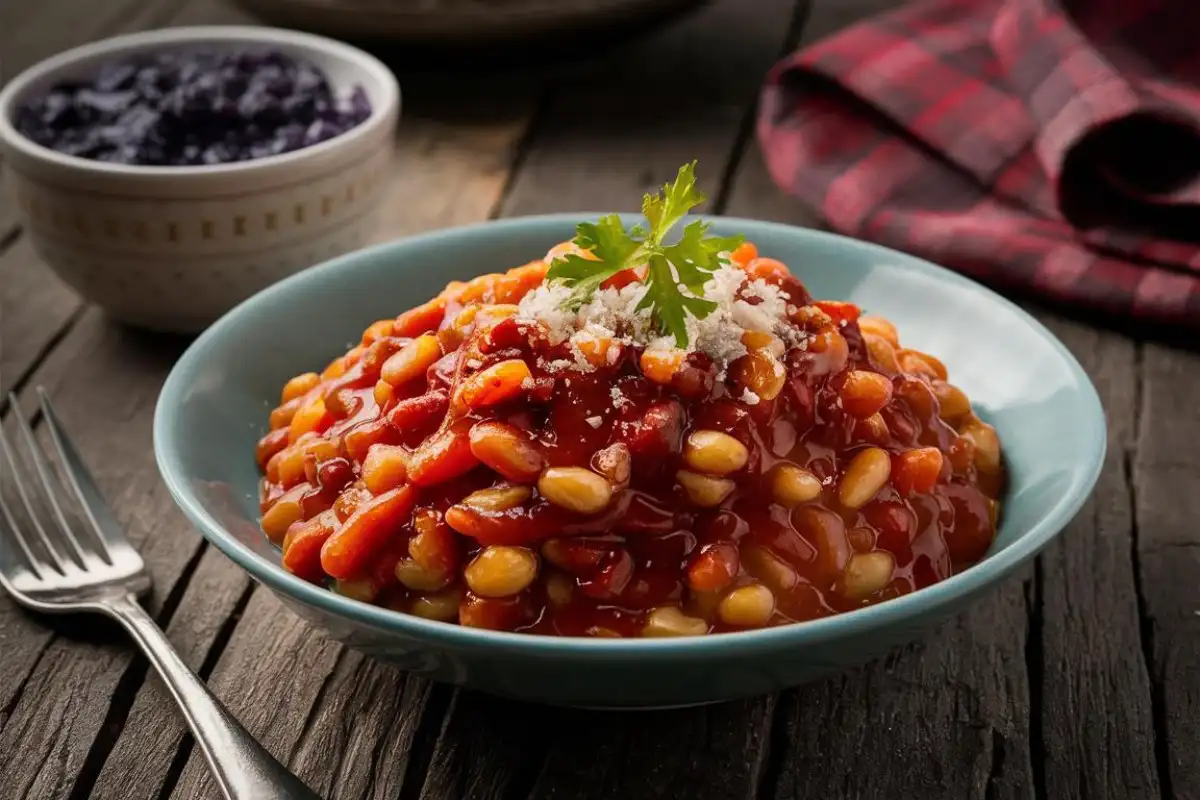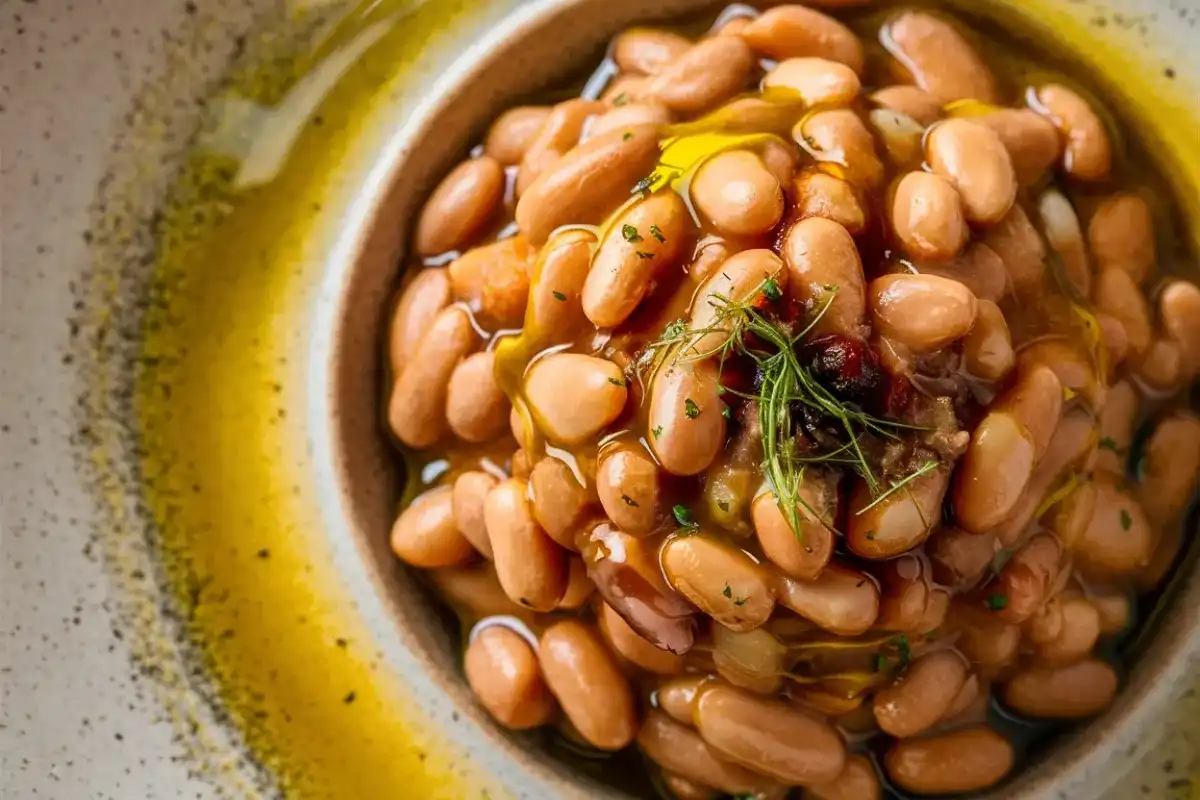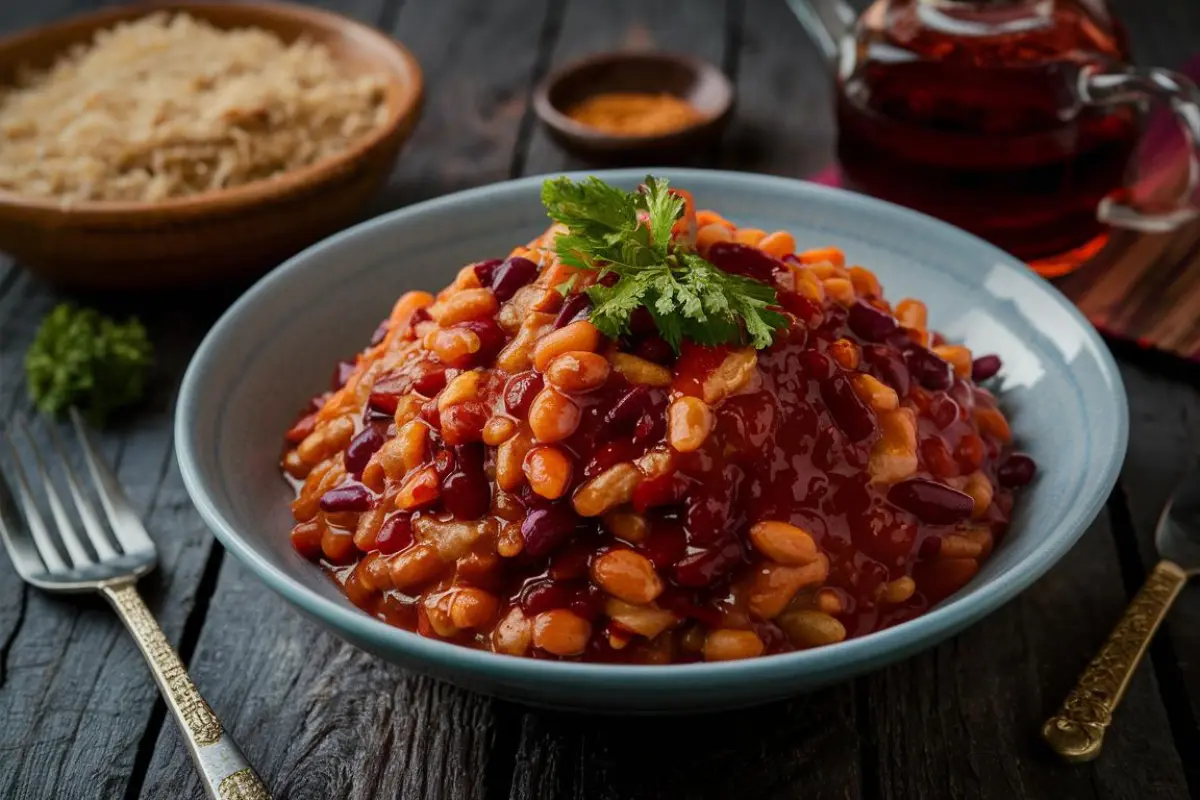Introduction to Baked Beans
This Baked Beans Recipe has become a staple in many kitchens around the world. This versatile food has its roots in various culinary traditions, from the early Native Americans who slow-cooked beans with bear fat and maple syrup to the British who adapted the recipe to include molasses and pork. Over time, baked beans have become a staple in American cuisine, particularly in the Northeast, where they are often served at family gatherings, barbecues, and potlucks.
The beauty of baked beans lies in their simplicity. At their core, they are just beans, but the magic happens when these humble legumes are slow-cooked with a mix of savory and sweet ingredients. The result is a dish that is rich, flavorful, and deeply satisfying. Whether you’re a novice cook or an experienced chef, mastering the baked beans recipe is a must-have skill that will serve you well in countless meals.
The Cultural Significance of Baked Beans
Throughout history, baked beans have played an important role in different cultures. In New England, for example, baked beans are traditionally served on Saturday nights. This tradition dates back to the Puritans, who would prepare a pot of baked beans on Saturday so they could observe the Sabbath without cooking. The dish would cook slowly overnight, ready to be enjoyed the next day.
In the UK, a Baked Beans Recipe is a quintessential part of the traditional full English breakfast. Served alongside eggs, sausages, and toast, they add a hearty and comforting element to the meal. British baked beans are typically sweeter and less smoky than their American counterparts, often made with tomato sauce as a base.
Why Make Baked Beans at Home?
While it might be tempting to reach for a can of pre-made baked beans from the grocery store, making them from scratch at home is a rewarding experience that offers several advantages. For one, you have complete control over the ingredients. You can adjust the sweetness, smokiness, and overall flavor to suit your taste. Additionally, making baked beans at home allows you to experiment with different types of beans and flavorings, creating a dish that is uniquely yours.
Moreover, homemade baked beans tend to have a richer and more complex flavor than store-bought versions. The slow cooking process allows the beans to absorb all the flavors of the sauce, resulting in a dish that is deeply satisfying and comforting. Check out these creative ways to use leftover taco shells, which might inspire you to add a unique twist to your baked beans by incorporating unexpected ingredients.

Essential Ingredients for the Best Baked Beans
The key to making the best baked beans lies in selecting high-quality ingredients and balancing the flavors. While there are countless variations of baked beans recipes, certain ingredients are essential to achieving that classic, mouthwatering flavor.
The Beans
At the heart of any baked beans recipe are, of course, the beans. Navy beans are the most commonly used variety in traditional baked beans, but other types like pinto beans, cannellini beans, or even black beans can be used for different textures and flavors. The choice of beans can greatly influence the final dish, so it’s worth experimenting to find your favorite.
- Navy Beans: Small, white beans that are tender when cooked and absorb flavors well.
- Pinto Beans: Slightly larger with a creamier texture, adding a different depth to the dish.
- Cannellini Beans: White kidney beans that are slightly firmer, offering a different bite.
- Black Beans: For a more robust flavor, black beans add an earthy note to the recipe.
The Meat
While not all baked beans recipes include meat, many traditional versions do. Bacon is the most popular choice, providing a smoky flavor that pairs beautifully with the sweet and savory sauce. Some recipes also call for salt pork, which adds a more intense, salty flavor.
- Bacon: Adds smokiness and richness; choose thick-cut for the best texture.
- Salt Pork: Provides a more intense pork flavor, often used in traditional New England recipes.
- Sausage: For a heartier dish, adding sliced sausage can turn baked beans into a main course.
The Sweeteners
One of the defining characteristics of baked beans is their sweet and savory flavor profile. This is achieved by using a combination of sweeteners such as brown sugar, molasses, or maple syrup. Each sweetener brings its unique flavor to the dish.
- Brown Sugar: Adds a deep, caramel-like sweetness that complements the smokiness of the bacon.
- Molasses: Provides a rich, slightly bitter sweetness that adds complexity to the dish.
- Maple Syrup: Offers a lighter, more floral sweetness that pairs well with the beans.
The Acid
To balance the sweetness, most baked beans recipes include an acidic component, typically in the form of tomato paste, ketchup, or vinegar. This helps to cut through the richness of the dish and adds a tangy note that brightens the overall flavor.
- Tomato Paste: Adds a deep, umami flavor that enhances the savory elements of the dish.
- Ketchup: Provides both sweetness and acidity, often used in American-style baked beans.
- Vinegar: Adds a sharp tang that balances the sweetness, with apple cider vinegar being a popular choice.
The Aromatics
Aromatics like onions and garlic are essential for building the flavor base of your baked beans. They add depth and complexity to the dish, making it more savory and satisfying.
- Onions: Diced and sautéed, onions provide a sweet, caramelized flavor.
- Garlic: Adds a pungent, savory note that enhances the overall flavor.
The Spices
Finally, spices are what elevate baked beans from good to great. A blend of smoked paprika, black pepper, and mustard powder can add warmth and complexity to the dish. Some recipes also call for a dash of cayenne pepper or hot sauce for a bit of heat.
- Smoked Paprika: Adds a smoky depth without needing additional meat.
- Black Pepper: Provides a subtle heat that enhances the overall flavor.
- Mustard Powder: Adds a tangy note that complements the sweetness of the beans.
- Cayenne Pepper: For those who like a bit of heat, cayenne pepper adds a spicy kick.
If you’re looking for more inspiration, consider trying a taco pasta recipe. The combination of flavors could inspire you to add a Tex-Mex twist to your baked beans.
Step-by-Step Guide to Making Baked Beans
Now that we’ve covered the essential ingredients, it’s time to dive into the cooking process. Making baked beans from scratch requires a bit of time and patience, but the result is well worth the effort. Below, we outline three different methods for making baked beans: the traditional oven-baked method, the slow cooker method, and the stovetop method.
Preparation
Before you start cooking this Baked Beans Recipe, it’s important to prepare all of your ingredients. This includes soaking the beans (if you’re using dried beans), cooking the bacon or other meats, and chopping the vegetables.
- Soak the Beans: If you’re using dried beans, rinse them thoroughly and soak them in water overnight. This helps to soften the beans and reduces cooking time. If you’re using canned beans, simply drain and rinse them before use.
- Cook the Bacon: In a large skillet, cook the bacon over medium heat until it is crispy. Remove the bacon from the skillet and place it on a paper towel to drain. Reserve a tablespoon or two of the bacon fat to sauté the onions and garlic.
- Sauté the Vegetables: In the same skillet, add the diced onions and garlic. Cook them in the reserved bacon fat until they are soft and translucent, about 5-7 minutes. This step helps to build the flavor base for the beans.
Cooking Methods
There are several ways to cook baked beans, each offering a slightly different texture and flavor. Below are three popular methods: oven-baked, slow cooker, and stovetop.
Oven-Baked Method
The oven-baked method is the most traditional way to make baked beans. It allows the beans to cook slowly, absorbing all the flavors of the sauce while developing a rich, caramelized exterior.
- Preheat the Oven: Set your oven to 350°F (175°C).
- Combine Ingredients: In a large Dutch oven or casserole dish, combine the soaked or canned beans with the sautéed onions, garlic, tomato paste, brown sugar, molasses, mustard powder, and spices. Stir to combine.
- Bake: Cover the dish with a lid or aluminum foil and bake for 2 to 3 hours, stirring occasionally. The beans should be tender, and the sauce should be thick and caramelized.
- Finish with Bacon: In the last 30 minutes of cooking, crumble the cooked bacon over the top of the beans and return to the oven uncovered. This allows the bacon to crisp up and the sauce to thicken further.
- Serve: Once the beans are done, remove them from the oven and let them cool slightly before serving. The beans will thicken as they cool, creating a rich and hearty dish.
Slow Cooker Method
The slow cooker method is perfect for those who want to set it and forget this Baked Beans Recipe. This method allows the beans to cook slowly over several hours, resulting in a tender and flavorful dish.
- Combine Ingredients: In a slow cooker, combine the soaked or canned beans with the sautéed onions, garlic, tomato paste, brown sugar, molasses, mustard powder, and spices. Stir to combine.
- Cook on Low: Set the slow cooker to low and cook the beans for 6 to 8 hours, stirring occasionally. The beans should be tender, and the sauce should be thick and rich.
- Add Bacon: In the last hour of cooking, crumble the cooked bacon over the top of the beans. This allows the bacon to infuse the dish with its smoky flavor.
- Serve: Once the beans are done, turn off the slow cooker and let the beans cool slightly before serving. The slow cooker method results in beans that are incredibly tender and flavorful.
Stovetop Method
The stovetop method is the quickest way to make baked beans, but it requires a bit more attention to prevent the beans from sticking to the pot. This method is ideal for those who want a faster, yet still flavorful, version of baked beans.
- Combine Ingredients: In a large pot, combine the soaked or canned beans with the sautéed onions, garlic, tomato paste, brown sugar, molasses, mustard powder, and spices. Stir to combine.
- Simmer: Bring the mixture to a boil over medium-high heat, then reduce the heat to low and simmer for 1 to 2 hours, stirring occasionally. The beans should be tender, and the sauce should be thick.
- Add Bacon: In the last 30 minutes of cooking, crumble the cooked bacon over the top of the beans and continue to simmer until the sauce is thick and the bacon is crispy.
- Serve: Once the beans are done, remove the pot from the heat and let the beans cool slightly before serving. The stovetop method results in beans that are slightly firmer with a rich, flavorful sauce.

Serving Suggestions & Variations
One of the best things about baked beans is their versatility. They can be served as a side dish, a main course, or even as part of a larger spread. Below are some serving suggestions and variations to inspire your next meal.
Best Pairings
This Baked Beans Recipe is the perfect accompaniment to a wide variety of dishes. Their sweet and savory flavor makes them a great match for both grilled meats and lighter fare.
- BBQ Ribs: The smoky sweetness of baked beans pairs beautifully with the rich, charred flavor of BBQ ribs. This is a classic combination that is sure to please any crowd.
- Grilled Chicken: For a lighter option, serve baked beans alongside grilled chicken. The beans add a hearty element to the meal, while the chicken provides a lean protein.
- Cornbread: Cornbread is a natural partner for baked beans. The sweet, crumbly texture of the cornbread complements the rich, saucy beans perfectly.
- Pulled Pork: Another classic pairing, pulled pork and baked beans are a match made in heaven. The tender, smoky pork is balanced by the sweet and tangy beans, creating a satisfying and flavorful meal.
Popular Variations
While the classic baked beans recipe is always a crowd-pleaser, there are countless variations you can try to mix things up. Here are a few ideas:
- Vegetarian/Vegan: For a vegetarian version of this Baked Beans Recipe, omit the bacon and add extra smoked paprika. You can also add chopped vegetables like bell peppers or mushrooms for extra texture and flavor.
- Spicy Baked Beans: If you like your food with a bit of heat, try adding chopped jalapeños, cayenne pepper, or hot sauce to your baked beans. The spice adds a new dimension to the dish, making it even more flavorful and exciting.
- Sweet and Tangy: For a slightly different take on baked beans, increase the amount of brown sugar and add a splash of apple cider vinegar. This creates a sweet and tangy flavor profile that is sure to be a hit.
- Maple-Bacon Baked Beans: For a rich, decadent version of baked beans, try using maple syrup instead of brown sugar and molasses. The maple syrup adds a deep, caramel-like sweetness that pairs beautifully with the smoky bacon.
- Tex-Mex Baked Beans: Add a Southwestern twist to your baked beans by incorporating ingredients like cumin, chili powder, and diced tomatoes. Serve with tortilla chips or cornbread for a Tex-Mex inspired meal.
Tips, Tricks & Common Mistakes
Making baked beans might seem straightforward, but there are a few tips and tricks that can help you achieve the best results. Here are some common mistakes to avoid and tips for perfect baked beans every time.
Tips for Perfect Baked Beans
- Taste as You Go: One of the most important tips for making baked beans is to taste the dish as you go. This allows you to adjust the seasoning and balance the flavors before the dish is finished.
- Use Fresh Spices: The quality of your spices can have a big impact on the final flavor of your baked beans. Make sure your spices are fresh and fragrant for the best results.
- Cook Low and Slow: Whether you’re using the oven, slow cooker, or stovetop method, it’s important to cook the baked beans low and slow. This allows the beans to absorb all the flavors of the sauce and become tender and flavorful.
- Stir Occasionally: When cooking baked beans, be sure to stir them occasionally to prevent sticking and ensure even cooking.
- Let Them Rest: Once your baked beans are done cooking, let them rest for a few minutes before serving. This allows the sauce to thicken and the flavors to meld together.
Common Mistakes to Avoid
- Overcooking the Beans: Overcooking baked beans can result in a mushy texture. Keep an eye on the beans and test for doneness periodically.
- Not Soaking Dried Beans: If you’re using dried beans, it’s important to soak them overnight before cooking. This helps to soften the beans and reduces cooking time.
- Skipping the Sauté: Sautéing the onions and garlic before adding them to the beans is an important step that builds flavor. Don’t skip this step!
- Using Canned Beans Without Rinsing: If you’re using canned beans, be sure to drain and rinse them before adding them to the recipe. This removes any excess sodium and improves the overall flavor.
Storing, Reheating & Leftover Ideas

One of the great things about baked beans is that they taste even better the next day. Here are some tips for storing, reheating, and using up leftover baked beans.
Storing Baked Beans
- Refrigeration: Store leftover baked beans in an airtight container in the refrigerator for up to 4 days. The beans will continue to absorb the flavors of the sauce, making them even more delicious over time.
- Freezing: Baked beans freeze well, making them a great option for meal prep. Place the cooled beans in a freezer-safe container and freeze for up to 3 months. When you’re ready to eat them, thaw the beans in the refrigerator overnight and reheat on the stovetop or in the microwave.
Reheating Baked Beans
- Stovetop: To reheat baked beans on the stovetop, place them in a pot over low heat and stir occasionally until heated through. If the beans have thickened too much in the fridge, you can add a splash of water or broth to loosen them up.
- Microwave: For a quicker option, reheat baked beans in the microwave. Place the beans in a microwave-safe dish, cover with a lid or microwave-safe wrap, and heat on high for 1-2 minutes, stirring halfway through.
Leftover Ideas
Leftover baked beans can be transformed into a variety of delicious meals. Here are some ideas for using up your leftovers:
- Baked Beans on Toast: A British classic, baked beans on toast is a quick and easy meal that is perfect for breakfast, lunch, or dinner. Simply toast a slice of bread, top it with warmed baked beans, and sprinkle with grated cheese.
- Baked Bean Chili: Turn your leftover baked beans into a hearty chili by adding ground beef or turkey, diced tomatoes, and chili powder. Serve with cornbread or over rice for a comforting meal.
- Baked Bean Quesadillas: Spread leftover baked beans on a tortilla, sprinkle with cheese, and top with another tortilla. Cook in a hot skillet until the cheese is melted and the tortillas are crispy. Cut into wedges and serve with salsa and sour cream.
- Baked Bean Casserole: Combine leftover baked beans with cooked pasta, ground meat, and shredded cheese for a hearty casserole. Bake in the oven until bubbly and golden brown.
- Baked Bean Burgers: Mash leftover baked beans with breadcrumbs, an egg, and your favorite seasonings to form patties. Cook in a skillet until browned on both sides and serve on a bun with your favorite toppings.
Frequently Asked Questions (FAQs)
Can baked beans be made without bacon?
Yes, baked beans recipe can be made without bacon for a vegetarian or vegan version. To achieve a smoky flavor without the bacon, you can use smoked paprika, liquid smoke, or even chipotle peppers in adobo sauce.
What are the best beans to use for baked beans?
Navy beans are the traditional choice for baked beans, but you can also use pinto beans, cannellini beans, or black beans. Each type of bean offers a slightly different texture and flavor, so feel free to experiment to find your favorite.
How can I make my baked beans less sweet?
If your baked beans recipe is too sweet for your taste, you can balance the sweetness by adding a bit more vinegar, mustard, or even a dash of hot sauce. You can also reduce the amount of sweeteners used in the recipe, such as brown sugar, molasses, or maple syrup.
Can I use a slow cooker to make baked beans?
Absolutely! The slow cooker is a great method for making baked beans recipe, as it allows the beans to cook slowly and absorb all the flavors of the sauce. Simply combine all the ingredients in the slow cooker and cook on low for 6 to 8 hours.
How do I thicken baked beans if they’re too watery?
If your baked beans recipe is too watery, you can thicken the sauce by mashing a portion of the beans with the back of a spoon or a potato masher. You can also simmer the beans uncovered for the last 30 minutes of cooking to allow some of the liquid to evaporate.
Are baked beans easy to freeze?
Yes, baked beans freeze very well. Make sure to cool the beans completely before transferring them to a freezer-safe container. When you’re ready to eat them, simply thaw the beans in the refrigerator overnight and reheat them on the stovetop or in the microwave.
Conclusion
Crafting the perfect Baked Beans Recipe is a culinary skill that every home cook should master. Whether you’re serving them as a side dish at a summer barbecue or enjoying them as a hearty main course, baked beans are a versatile and satisfying dish that can be customized to suit your taste. With the tips, tricks, and variations outlined in this guide, you’re well on your way to creating a batch of baked beans that will impress your family and friends. So grab your ingredients, set aside some time, and get ready to enjoy the comforting, flavorful goodness of homemade baked beans. Happy cooking!

